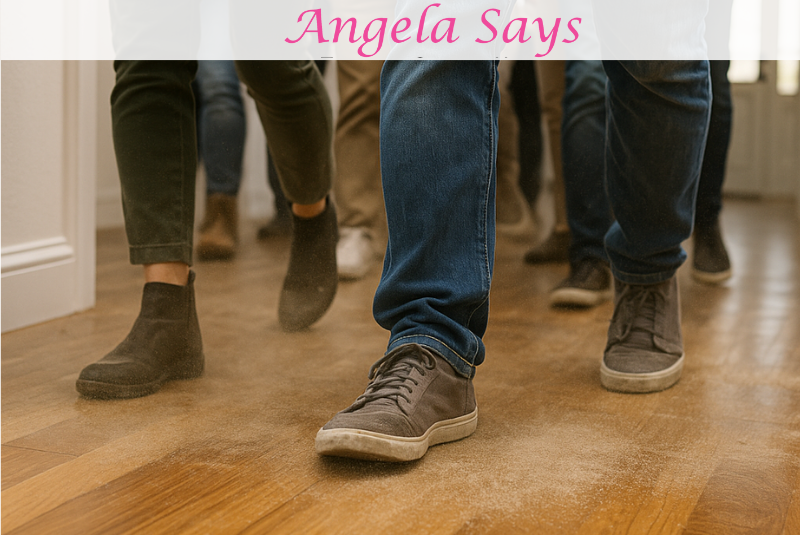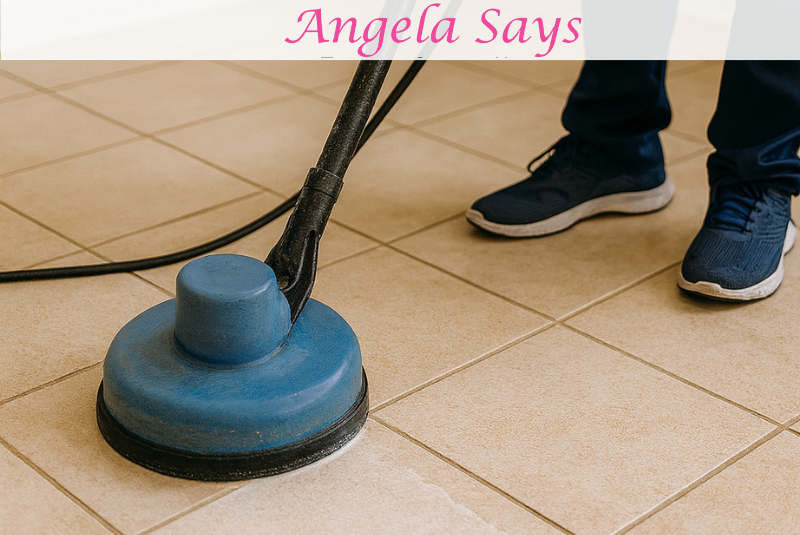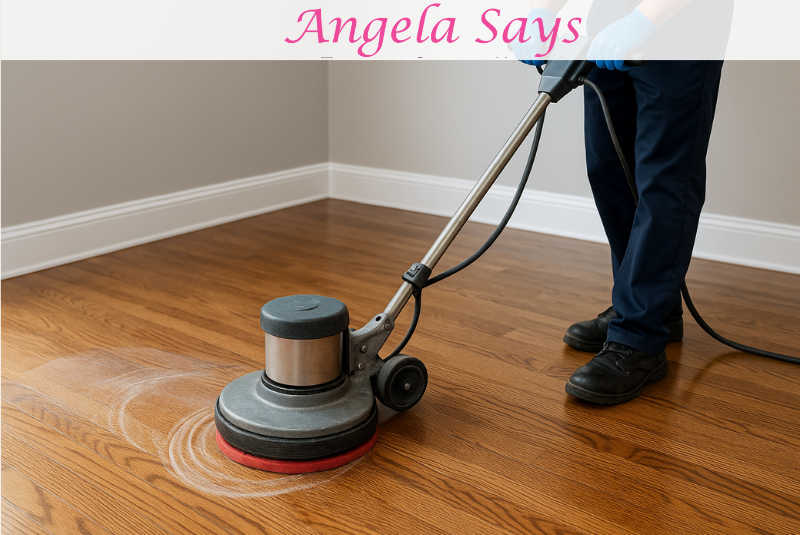Effective Deep Cleaning: Removing Extra Foot Traffic Grime from Rugs, Tile, and Entryways

When your home experiences heavy foot traffic—whether from holiday gatherings, seasonal weather, or frequent visitors—it takes a real toll on rugs, tile, wood floors, and entryways. Shoes track in dirt, moisture, and grime that gradually work their way into fibers, grout lines, and floor finishes, leaving surfaces looking dull and worn out.
A routine sweep or vacuum can help with surface dirt, but it isn’t enough to tackle the deep-seated grime that builds up after weeks of extra activity. That’s where effective deep cleaning comes in. Not only does it restore your home’s appearance, but it also helps protect your flooring materials, reduce allergens, and create a healthier living environment for your family.
This guide walks through the essential steps for removing extra foot traffic grime from rugs, tile, wood floors, and entryways—and shows how to maintain them for lasting beauty and durability.
Understanding the Impact of Foot Traffic Grime

Foot traffic may seem harmless at first, but the constant movement of people across rugs, tile, wood floors, and entryways creates hidden layers of damage that build up over time. Each surface reacts differently to dirt, moisture, and debris, which makes targeted cleaning especially important.
1. Rugs and Carpets
Rugs absorb a large amount of dust, soil, and bacteria. With heavy foot traffic, dirt gets ground into the fibers, causing premature wear and making colors look dull. Additionally, lingering particles can trigger allergies and trap odors, particularly in damp or humid conditions.
2. Tile and Grout
Tile surfaces may resist dirt on the surface, but grout lines act like a sponge. Grime, spills, and moisture seep into porous grout, leaving behind discoloration and breeding grounds for mold or mildew. Over time, this can weaken the integrity of grout lines, making the floors appear older and more difficult to clean.
3. Wood Floors
Wood is especially vulnerable to grit and moisture. Dirt particles act like sandpaper, scratching the finish and dulling the shine. Foot traffic during wet weather can also cause water to seep into cracks, leading to warping, staining, or long-term damage.
4. Entryways
As the first line of defense, entryways are the most affected by outside contaminants. Salt from winter, mud from rain, and dirt from shoes accumulate quickly. Without regular deep cleaning, entryways can spread grime throughout the rest of the house.
Preparing for a Successful Deep Clean
Before tackling the actual cleaning, preparation is key to achieving effective and lasting results. A well-planned approach ensures that every area gets the attention it needs and prevents dirt from being spread around during the process.
1. Gather the Right Supplies
- For Rugs and Carpets: Non-toxic carpet cleaner, enzyme-based stain removers, and a high-suction vacuum with HEPA filtration.
- For Tile and Grout: a pH-balanced tile cleaner, a grout brush, a microfiber mop, and a steam cleaner for deeper penetration.
- For Wood Floors: Use a wood-safe cleaning solution, a microfiber mop, and a soft-bristled brush for tight spaces.
- For Entryways: Heavy-duty floor cleaner, shoe scrubbing mats, and absorbent drying cloths.
2. Prepare the Space
- Remove furniture, mats, and clutter to expose the full surface area.
- Place protective pads under heavy furniture that cannot be moved.
- Ensure good ventilation by opening windows or using fans to accelerate the drying process.
3. Address Immediate Concerns
- Spot-treat visible stains before starting the deep clean.
- Vacuum or sweep up loose dirt and debris to prevent it from spreading.
- Check for damage such as cracked tiles, frayed rugs, or warped wood—these should be repaired or handled carefully during cleaning.
4. Set Up Zones
Dividing the home into cleaning zones helps maintain efficiency. Start with entryways to remove the heaviest grime, then move inward to rugs, tile, and wood areas. This method prevents re-contaminating freshly cleaned surfaces.
Step-by-Step Deep Cleaning for Rugs and Carpets

Rugs and carpets absorb the majority of dirt, dust, and debris from heavy foot traffic, especially in entryways and living spaces. A proper deep rug cleaning not only revives their appearance but also extends their lifespan and improves indoor air quality.
1. Vacuum Thoroughly
- Start by vacuuming slowly in multiple directions to remove surface dirt and dust trapped deep in the fibers.
- Use a vacuum with a rotating brush or beater bar for high-pile carpets, and a suction-only setting for delicate rugs.
2. Spot Treatment
- Identify stains such as mud, food spills, or salt marks from shoes.
- Apply an enzyme-based or pH-neutral stain remover, then gently blot with a clean cloth. Avoid scrubbing, as this can damage fibers.
3. Deep Cleaning Methods
- Steam Cleaning: Penetrates fibers with hot water and cleaner to lift deep-set grime (works best for synthetic carpets).
- Dry Cleaning Powders: Ideal for wool and delicate rugs, these absorb dirt without excess moisture.
- Shampooing: Suitable for high-traffic areas, but requires thorough drying to prevent mold or mildew growth.
4. Drying Properly
- Use fans or dehumidifiers to speed up the drying process.
- Avoid walking on damp carpets to prevent dirt from embedding again.
5. Preventive Measures
- Apply carpet protectors or fabric guards to repel stains and spills.
- Place mats near entryways to catch dirt before it reaches rugs.
- Rotate rugs periodically to ensure even wear and fading.
Deep Cleaning Tile and Grout Surfaces

Tile and grout are especially vulnerable to extra foot traffic and grime after busy seasons. Entryways, kitchens, and hallways often experience dullness, staining, or discoloration due to dirt, salt, and moisture being tracked indoors. Professional tile and grout cleaning restores both appearance and hygiene.
1. Surface Preparation
- Sweep or vacuum the tiled area to remove loose dust, grit, and debris.
- This prevents scratching the tile during the cleaning process.
2. Targeting Grout Lines
- Grout is porous, making it a magnet for dirt and bacteria.
- Apply a pH-balanced grout cleaner or a paste of baking soda and water for mild cases.
- For tougher grime, an oxygenated bleach solution or professional-grade grout cleaner can be used.
- Scrub gently with a soft-bristled brush to lift buildup without damaging grout.
3. Tile Cleaning Methods
- Ceramic & Porcelain: Use a neutral pH tile cleaner to gently dissolve dirt without etching the surface.
- Natural Stone: Avoid using acidic cleaners, such as vinegar; instead, opt for stone-safe solutions.
- Steam Cleaning: Effective for breaking down grime and naturally sanitizing grout.
4. Rinse and Dry
- Rinse thoroughly with warm water to remove any residue from the cleaning solution.
- Dry floors with microfiber cloths or allow proper air circulation to prevent water spots.
5. Sealing for Protection
- Apply a grout sealer to create a barrier against future stains and moisture.
- This not only extends cleanliness but also improves durability.
6. Preventive Practices
- Place mats both inside and outside entryways to reduce dirt tracked indoors.
- Implement a weekly mopping routine using mild cleaners to minimize buildup.
- Encourage family members and guests to remove their shoes in high-traffic areas to help preserve the flooring.
Restoring Shine and Protection to Wood Floors

Wood floors are particularly susceptible to dullness and scratches after prolonged periods of heavy foot traffic. Dirt, grit, and moisture can settle into the surface, diminishing its natural luster. A deep wood floor cleaning routine not only revives their appearance but also extends their life.
1. Initial Cleaning
- Begin by sweeping or vacuuming with a soft-bristle attachment to remove dust, grit, and debris that can scratch the wood.
- Pay special attention to entryways where particles often accumulate.
2. Spot Treatment for Stains
- For sticky spots or mud, use a damp microfiber cloth with a mild, wood-safe cleaner.
- Avoid excessive water as it can seep into seams and cause warping.
3. Deep Cleaning Method
- Use a wood floor cleaner specifically designed for hardwood or engineered wood.
- Apply with a slightly damp mop, working in sections to prevent oversaturation.
- For deeper restoration, professional buffing or polishing can help even out light scratches.
4. Drying and Buffing
- Ensure the floor dries quickly by using fans or opening windows for ventilation.
- Buff gently with a dry microfiber pad to restore shine and smoothness.
5. Protection with Sealants or Polish
- Apply a protective finish such as polyurethane, wax, or polish, depending on the type of flooring.
- This adds a barrier against moisture, stains, and scuffing while enhancing natural beauty.
6. Preventive Maintenance
- Place mats at doors to reduce dirt tracked inside.
- Add felt pads under furniture legs to avoid scratches.
- Implement a weekly routine of dusting or light mopping to preserve shine.
Entryway Cleaning and Maintenance
Entryways are the first line of defense against dirt, grime, and moisture entering your home. Because they experience the highest concentration of foot traffic, they require special attention during a deep cleaning routine. A well-maintained entryway not only improves the look of your home but also prevents dirt from spreading to other areas.
1. Removing Surface Dirt and Debris
- Start by thoroughly sweeping or vacuuming the entryway to capture dirt, grit, and leaves that often get tracked indoors.
- Use a crevice tool for corners and baseboards where dust tends to collect.
2. Deep Cleaning Floors
- For tile or stone entryways, use a neutral pH cleaner to mop the area, removing grime without dulling the surface.
- If you have wood, follow a damp-mop routine with wood-safe cleaners to avoid moisture damage.
- Rugs or mats in entryways should be shaken outside and vacuumed on both sides.
3. Addressing Stains and Buildup
- Mud, water stains, or salt residue (especially in winter) can damage surfaces if left untreated.
- Use a targeted cleaner for tough stains—such as an enzymatic solution for organic grime or a vinegar-water mix for salt buildup.
4. Maintaining Entryway Rugs and Mats
- Wash machine-safe mats with mild detergent, or hire a professional cleaner for larger entry rugs.
- Rotate mats regularly to distribute wear evenly and prolong their life.
5. Protective Measures
- Place both outdoor and indoor mats to reduce the dirt tracked inside.
- Use boot trays in wet seasons to catch water and mud.
- Seal grout lines or wood finishes for added protection against future staining.
6. Long-Term Maintenance Tips
- Establish a routine of vacuuming or sweeping entryways at least twice a week.
- Replace heavily worn mats yearly to maintain cleanliness and effectiveness.
- During periods of heavy foot traffic (such as holidays, gatherings, or wet weather), increase the cleaning frequency.
Professional Deep Cleaning Benefits
While regular upkeep can handle surface dirt and daily messes, professional deep cleaning brings an added level of care and effectiveness that household routines often cannot match. Rugs, tile, and entryways experience constant wear and tear, and over time, grime becomes embedded deep into fibers and grout lines. Here’s why calling in the experts can make a significant difference:
1. Advanced Equipment and Techniques
- Professionals utilize industry-grade cleaning systems specifically designed to extract dirt and contaminants that are lodged deep within carpets, rugs, and tile grout.
- Unlike standard household vacuums or mops, these tools ensure a more thorough and long-lasting clean.
2. Specialized Solutions for Each Surface
- Experts tailor their methods to the type of flooring—using safe, pH-balanced cleaners for tile and grout, wood-safe solutions for hardwood, and fiber-specific treatments for rugs.
- This prevents unnecessary wear and extends the life of each surface.
3. Restoring Original Appearance
- Over time, high-traffic grime can dull the appearance of flooring and rugs. Professional deep cleaning revives colors, restores shine, and brings back the fresh look of entryways.
- Stubborn stains, salt deposits, and buildup are treated effectively without damaging surfaces.
4. Health and Hygiene Benefits
- Professional-grade cleaning eliminates allergens, bacteria, and mold spores that often accumulate in rugs and grout lines.
- Cleaner floors contribute to improved indoor air quality, making the home safer and healthier for families.
5. Long-Term Protection
- Many services offer protective treatments such as grout sealing, rug fiber protection, and wood floor sealing.
- These measures help guard against future stains, moisture, and grime buildup, reducing the need for frequent deep cleans.
6. Time and Energy Savings
- Deep cleaning is labor-intensive when done alone. Professional services save time and energy while delivering better results.
- This is especially valuable after events, holidays, or seasons when foot traffic is at its peak.
Seasonal Maintenance Tips
Deep cleaning after periods of heavy foot traffic is essential, but maintaining floors in their best condition year-round requires ongoing seasonal care. By adjusting your cleaning routine to the time of year, you can reduce buildup and extend the life of your rugs, tile, and entryways.
1. Winter Care
- Place heavy-duty mats both inside and outside entryways to trap snow, salt, and mud.
- Vacuum rugs more frequently, especially near entrances, to prevent salt and grit from embedding into fibers.
- Mop tile floors regularly with warm water to remove salt residues that can cause discoloration.
2. Spring Refresh
- Pollen and dust increase during spring, making rugs and entryways key areas for allergen buildup.
- Deep clean rugs and sweep entryways daily to reduce tracked-in pollen.
- Consider sealing grout lines after a professional clean to prevent future staining during humid months.
3. Summer Upkeep
- With more outdoor activities, dirt and sand often find their way indoors.
- Shake out entry mats weekly and vacuum rugs often to prevent abrasive grit from wearing down fibers.
- Spot clean spills immediately to prevent stains from setting during warmer months.
4. Fall Preparation
- Before colder weather sets in, schedule a professional deep clean to remove grime accumulated during summer.
- Refresh doormats to ensure they are effective at trapping debris before winter arrives.
- Inspect wood and tile surfaces for scratches or cracks that may worsen in dry, cold conditions.
By tailoring your floor care routine to each season, you’ll prevent excessive grime buildup and reduce the need for emergency deep cleaning.
Conclusion: Protecting Your Floors for the Long Run
Deep cleaning rugs, tile, and entryways is more than just an aesthetic choice—it’s an investment in your home’s health, cleanliness, and longevity. By addressing the grime that accumulates from heavy foot traffic, you prevent long-term damage, such as embedded dirt in rugs, permanent grout stains, and scratches on hard surfaces.
Routine care, paired with seasonal upkeep and periodic professional cleaning, ensures your floors remain welcoming, safe, and durable for years to come. Whether it’s protecting high-traffic entryways or restoring the natural shine of wood and tile, consistent maintenance pays off with a fresher, healthier living space.
If you’ve noticed stubborn stains, dullness, or persistent dirt that regular cleaning can’t handle, it may be time for a professional deep clean. Trained technicians utilize specialized equipment and safe cleaning methods to restore your floors and rugs to their optimal condition, while preventing long-term wear.
